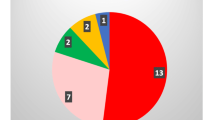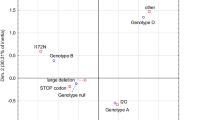Abstract
The spectrum of mutated alleles in non-classical congenital adrenal hyperplasia (NC-CAH) has been recently reported to be very large and haplotypes may significantly differ in the different ethnic groups. In order to confirm that population differences may exist in the genetic basis of this disease, we have analyzed the genetic presentation of NC-CAH in a Sicilian cohort of symptomatic patients and compared our findings with the ones reported in other studies of different ethnic groups. In 38 NC-CAH patients coming from two regions of Sicily and born of Sicilian parents, we found that 84.2% of the chromosomes examined bore only mild mutations and only the remaining 15.8% of the chromosomes bore at least 1 severe mutation. The overall predominant mutation was V281L, which was detected in 73.7% of alleles and in 89.5% of patients. About 58% of the patients were homozygotes for this mutation. V281L allele and homozygote frequencies were higher in the present series than in other European and Italian reports. In our NC-CAH population, which is one of the largest ever reported, the patients with two mild mutations exhibited a less severe impairment of both clinical and endocrine phenotype. On the basis of these results we can conclude that: a) in Sicilian ethnic groups NC-CAH is frequently associated with a very mild genotype; b) the most frequent genotype in our series is V281L homozygosis; c) clinical and biochemical expression of NC-CAH is more marked in the patients bearing a severe mutation; d) no correlations between genotype and phenotype were found in our patients affected by NC-CAH.
Similar content being viewed by others

References
White PC, Tusie-Luna MT, New MI, Speiser PW. Mutations in steroid 21-hydroxylase (CYP21). Hum Mutat 1994, 3: 373–8.
Rumsby G, Avey CJ, Conway GS, Honour JW. Genotype-phenotype analysis in late onset 21-hydroxylase deficiency in comparision to the classical forms. Clin Endocrinol (Oxf) 1998, 48: 707–11.
Deneux C, Tardy V, Dib A, et al. Phenotype-genotype correlation in 56 women with nonclassical congenital adrenal hyperplasia due to 21-hydroxylase deficiency. J Clin Endocrinol Metab 2001, 86: 207–13.
Loidi L, Quinteiro C, Parajes S, et al. High variability in CYP21A2 mutated alleles in Spanish 21-hydroxylase deficiency patients, six novel mutations and a founder effect. Clin Endocrinol (Oxf) 2006, 64: 330–6.
Balsamo A, Cacciari E, Baldazzi L, et al. CYP21 analysis and phenotype/genotype relationship in the screened population of the Italian Emilia-Romagna region. Clin Endocrinol (Oxf) 2000, 53: 117–25.
Day DJ, Speiser PW, Schulze E, et al. Identification of non-amplifying CYP21 genes when using PCR-based diagnosis of 21-hydroxylase deficiency in congenital adrenal hyperplasia (CAH) affected pedigrees. Hum Mol Genet 1996, 5: 2039–48.
White PC, New MI, Dupont B. Structure of human steroid 21-hydroxylase genes. Proc Natl Acad Sci USA 1986, 83: 511–5.
Nikoshkov A, Lajic S, Vlamis-Gardikas A, et al. Naturally occurring mutants of human steroid 21-hydroxylase (P450c21) pinpoint residues important for enzyme activity and stability. J Biol Chem 1998, 273: 6163–5.
Krone N, Braun A, Roscher AA, Knorr D, Schwarz HP. Predicting phenotype in steroid 21-hydroxylase deficiency? Comprehensive genotyping in 155 unrelated, well-defined patients from southern Germany. J Clin Endocrinol Metab 2000, 85: 1059–65.
Wedell A, Thilen A, Ritzen EM, Stengler B, Luthman H. Mutational spectrum of the steroid 21-hydroxylase gene in Sweden: implications for genetic diagnosis and association with disease manifestation. J Clin Endocrinol Metab 1994, 78: 1145–52.
Stikkelbroeck NMML, Hoefsloot LH, De Wijs IJ, Otten BJ, Hermus RMM, Sistermans EA. CYP21 gene mutation analysis in 198 patients with 21-hydroxlase deficiency in the Netherlands: six novel mutations and a specific cluster of four mutations. J Clin Endocrinol Metab 2003, 88: 3852–9.
Pinto G, Tardy V, Trivin C, et al. Follow-up of 68 children with congenital adrenal hyperplasia due to 21-hydrxylase deficiency: relevance of genotype for management. J Clin Endocrinol Metab 2003, 88: 2624–33.
Carrera P, Bordone L, Azzani T, et al. Point mutations in Italian patients with classic, non classic, an cryptic forms of steroid 21-hydroxylase deficiency. Hum Genet 1996, 98: 662–5.
Speiser PW, Dupont B, Rubinstein P, et al. Disease expression and molecular genotype in congenital adrenal hyperplasia due to 21-hydroxylase deficiency. J Clin Invest 1992, 90: 584–95.
Author information
Authors and Affiliations
Corresponding author
Rights and permissions
About this article
Cite this article
Wasniewska, M., Di Pasquale, G., Rulli, I. et al. In Sicilian ethnic group non-classical congenital adrenal hyperplasia is frequently associated with a very mild genotype. J Endocrinol Invest 30, 181–185 (2007). https://doi.org/10.1007/BF03347422
Accepted:
Published:
Issue Date:
DOI: https://doi.org/10.1007/BF03347422



